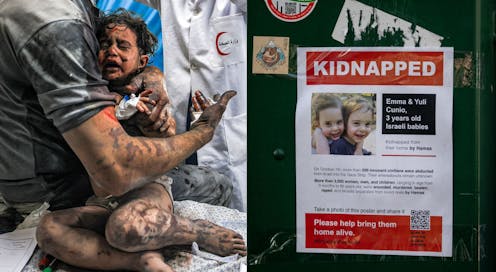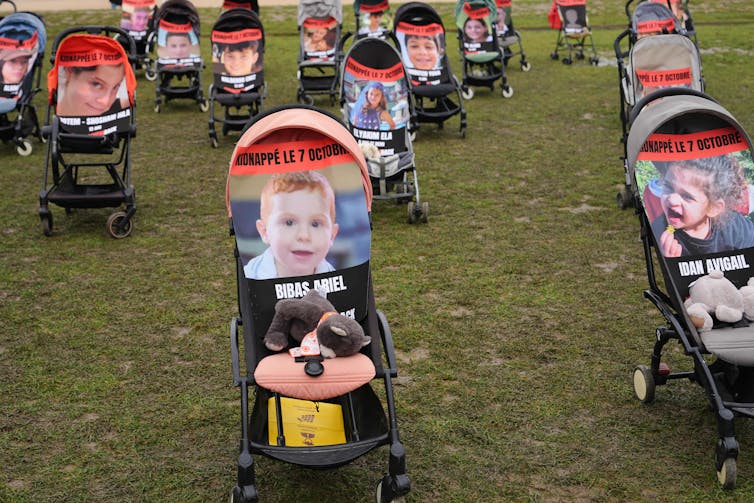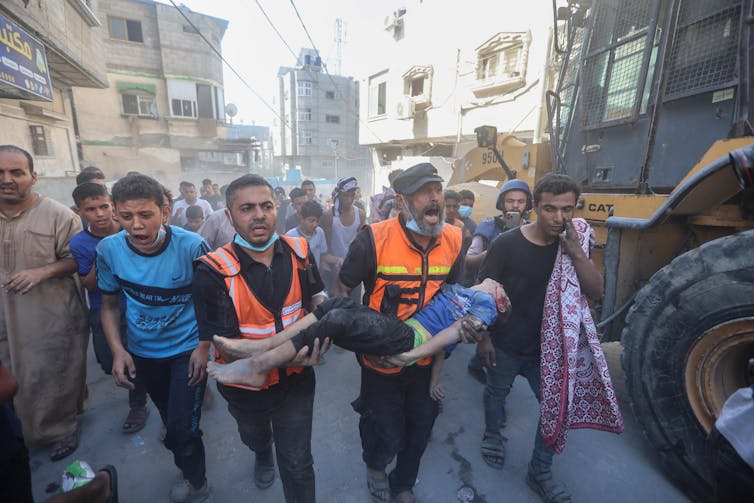In the Israel-Hamas war, children are the ultimate pawns – and ultimate victims
For Jewish people, Hamas’ violence against children was reminiscent of the Holocaust. For Palestinians, The Israel Defense Force’s killing their children reminds them of a painful past, too.

In 1903, a local mob killed 49 Jews, including several children, and raped and wounded 600 others, in the city of Kishinev, then part of the Russian Empire. These three days of violence later became known as the Kishinev pogrom.
A few days later, the Jewish-Russian poet Hayim Nahman Bialik published a Hebrew poem that every Israeli school child still knows today.
I am a scholar of the Holocaust and genocide. When thinking about the unfolding Israel-Hamas war, I am reminded of this Bialik poem, “On the Slaughter.” It laments Jewish helplessness and victimhood – and condemns apathy to violence, including the murder of children.
Bialik writes:
“And damned be he who says: Avenge!
Such vengeance, for the blood of a small child,
Satan has yet to devise.”
Hamas militants killed approximately 30 Israeli children when they attacked civilians on Oct. 7, 2023, killing more than 1,400 people altogether. At least 20 Israeli children remain hostage in Gaza.
Since Oct. 7, Israeli airstrikes have killed more than 2,000 Palestinian children and more than 8,000 people overall, according to the Hamas-run Ministry of Health in Gaza.
Israel’s attacks on Gaza began intensifying on Oct. 28, as Israeli ground forces entered Gaza.
Both sides in this war have focused on the deaths and kidnapping of children, sharing images and videos of the children as a testament to the other side’s cruelty.
Particularly, Hamas’ slaughter of Israeli children evokes collective Jewish memories of pogroms and the Holocaust – and the attempt to annihilate the Jewish people.
For Palestinians, too, the killing of their children represents both the injustice of Israeli rule and occupation, and the perceived attempt to stop Palestinians from having their own country. The collective Palestinian memory of the Nakba in 1948, when Israeli forces killed thousands of Palestinians and pushed out 750,000 people from their homes, is replete with tales of children who lost both their homeland and their parents.

A new kind of protection
Bialik ended up emigrating to what was then called Palestine in 1924, and today he is considered Israel’s national poet.
Bialik wrote a longer poem, titled “In The City of Slaughter,” in 1904, after he visited the site of the Kishinev pogrom. Bialik fumed against Jewish men for hiding, instead of protecting their wives and daughters from rape.
Bialik called for a new type of warlike Jewish manhood. If neither God nor the authorities could protect them from slaughter, Jews had to create a state of their own – and Jewish men had to learn to fight and kill.
Over the next four decades, the numbers of slaughtered Jews, including children, piled up.
In the Holocaust, Nazis and their collaborators killed an estimated 1.5 million Jewish children.
It was this kind of violence against defenseless innocents that the establishment of Israel in 1948 was supposed to prevent.
‘Never again’
Most Jews who emigrated to Israel in the late 1940s were Holocaust survivors. They had experienced precisely the kind of defenselessness that Israel said it would never allow to happen again. Their sense of vulnerability and their memory of victimization were transmitted from one generation to another.
The popular slogan “never again,” referring to the Holocaust, meant what Bialik had intended: not only the prevention of violence against Jewish people, but a new breed of tough and brave Jewish fighters, prepared to die for their new homeland.
Israel’s failure to protect its people is partially why the Oct. 7 attacks were so shocking to the Israeli public.
The Israeli military’s delayed response left people in the attacked communities feeling utter helplessness. The intentional cruelty of Hamas’ killings, often videotaped and live-streamed, reminded Israelis of past anti-Jewish violence.
Children in Gaza
In the Gaza Strip, meanwhile, half of the population is younger than 18.
In 2014, Israel airstrikes, coming in response to intense rocket fire from Gaza, killed over 500 Palestinian children. The Israeli government described the children’s deaths as unfortunate, but unavoidable. The reasoning is that bombing presumed Hamas targets was much less risky and costly, in terms of Israeli lives, than a ground incursion into Gaza.
Since Oct. 7, Israel has carried out unprecedentedly massive aerial bombardments of Gaza.
The images of dead and mutilated Palestinian children have served to mute some people’s criticism of Hamas’ Oct. 7 attacks on Israelis – and to heighten other people’s sense of Palestinian innocence and Israeli brutality.
There are two major difference between this round of killing and previous ones, most prominently in 2014.
First, this time the violence began with the slaughter of over 1,400 Israelis.
Second, Israel’s current bombing campaign has killed more Palestinians, including children, than at any other time in the past.
Hamas’ slaughter of Jewish children is now being reciprocated by what the Israel Defense Forces says are unintended – but certain – killings of even larger numbers of Palestinian children.

Children are the ultimate victims
Both sides in the Israel-Hamas war are now flaunting and weaponizing their child victims to support their political causes.
For the Israelis and their supporters, the murder and kidnapping of children shows the inhumanity of Hamas and its supporters – and fuels calls for violent retribution.
For Palestinians and their supporters, Israel’s killing of even more children in Gaza helps wipe away Hamas’ crimes and exposes Israel’s alleged intent to kill all Palestinians.
Many people have flooded social media with images and videos of killed Palestinian and Israeli children, as well as bloody crime scenes where they were killed.
People have plastered posters of kidnapped Israeli children across the streets in American and European cities – and have videotaped those who tear them down.
But in Israel, at least, the media has mostly avoided showing images of both Jewish and Palestinian child victims. Showing kidnapped or killed Israeli children is considered demoralizing, and showing killed Palestinian children is considered to be enemy propaganda. In Gaza, people have been photographed and recorded carrying and mourning dead children, wrapped in blood-stained white cloth.
Is this Satan’s vengeance for the violence of men? In his deepest hour of despair, Bialik never hoped for more violence as a response to a massacre. As he wrote 120 years ago:
“If there is justice – May it appear at once!
But if it appears
Only after I had been eradicated under the sky -
May its throne be toppled forever!
And may Heaven rot in everlasting evil.”
Omer Bartov does not work for, consult, own shares in or receive funding from any company or organization that would benefit from this article, and has disclosed no relevant affiliations beyond their academic appointment.
Read These Next
How the ‘slayer rule’ might play a role in determining who will inherit wealth from Rob Reiner and h
These rules have a long history in the United States. They played a role in the notorious murders by…
The celibate, dancing Shakers were once seen as a threat to society – 250 years later, they’re part
‘The Testament of Ann Lee,’ Mona Fastvold’s 2025 film, depicts part of the long history of Shaker…
From truce in the trenches to cocktails at the consulate: How Christmas diplomacy seeks to exploit s
World leaders like to talk up peace at Christmastime. But alongside the tales of seasonal breaks in…






